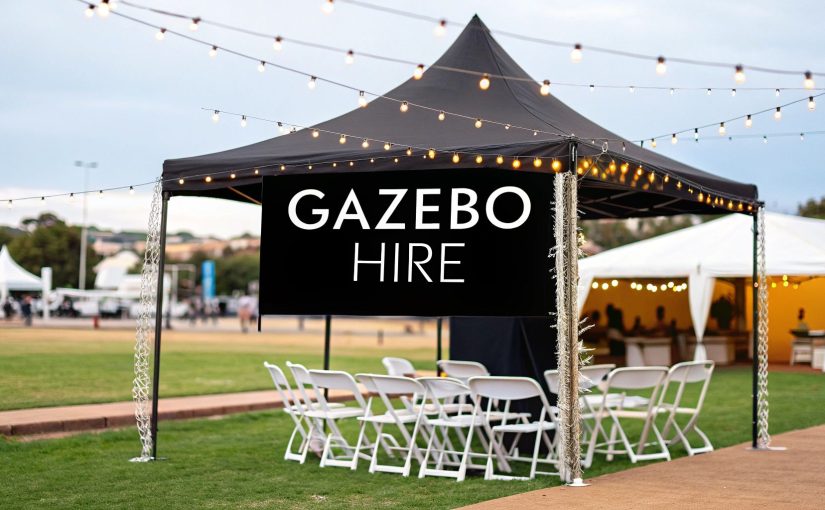When you’re planning an outdoor event in South Africa, a hired gazebo is almost always the smartest way to go. It’s a simple, stylish way to create a temporary shelter, saving you from the massive upfront cost of buying, the headache of storage, and the ongoing chore of maintenance.
Whether you’re hosting a small garden party or a big corporate do, hiring just makes sense.
Why Hiring a Gazebo is a No-Brainer for Your Next Event
Let’s be honest, South African weather is famously unpredictable. You can have glorious sunshine in Cape Town one minute, and a surprise downpour in Johannesburg the next. This makes having reliable shelter completely non-negotiable.
While buying a gazebo might seem like a decent investment, the reality of cleaning it, storing it, and dealing with potential damage often makes it a poor choice for a one-off event. This is where finding a quality gazebo for hire becomes a total game-changer. You’re not just getting cover; you’re getting convenience, value for money, and access to professional-grade gear you probably wouldn’t buy yourself.
The Practical Perks of Renting vs. Buying
Think about what owning a big gazebo actually involves. First, there’s the initial cost, which can be pretty steep for a model that won’t fall apart in the first gust of wind.
After the party’s over, you’ve got to clean the canopy and dry it properly to stop mould from setting in. Then comes the real challenge: where on earth do you store the bulky frame and all that fabric? For most of us, garage space is already jam-packed.
Hiring a gazebo sidesteps all of this drama. A professional rental company takes care of everything for you.
- No Storage Headaches: The gazebo gets delivered right before your event and picked up right after. It never clutters up your home.
- A Cost-Effective Choice: You only pay for the time you actually need it, making it far kinder on your budget than buying one outright.
- Access to Pro-Quality Gear: Rental gazebos are usually commercial-grade. They’re built tougher and are way more weather-resistant than the models you’d find in a retail store.
- Amazing Variety and Flexibility: Need a little 3x3m pop-up for a market stall? No problem. Planning a wedding and need a much larger, more elegant structure? You can get that too. You choose the perfect size and style for each specific event.
Real-World Scenarios Where Hiring Just Works
Let’s paint a picture. Imagine you’re organising a year-end corporate braai in the Winelands for about 30 people. You need a shelter that looks clean and professional. Hiring a sturdy, well-maintained gazebo ensures your setup looks the part without the company having to buy and store one.
Or maybe you’re a food vendor at a weekend market like the Neighbourgoods Market. Your needs can change from one week to the next. One Saturday you might need a single stall, but the next you might need two gazebos linked together with side walls for extra protection from the wind. A gazebo for hire service gives you that crucial flexibility.
The real beauty of hiring is that you can scale up or down whenever you need to. You’re never locked into one size or style, so you can perfectly match the shelter to the event, whether it’s an intimate family gathering or a massive public festival.
Ultimately, choosing to hire is a strategic move. It frees up your time, your budget, and your energy so you can focus on what really matters: creating an amazing experience for your guests. You get all the benefits of a top-quality shelter with none of the long-term burdens.
Choosing the Right Gazebo Size and Material
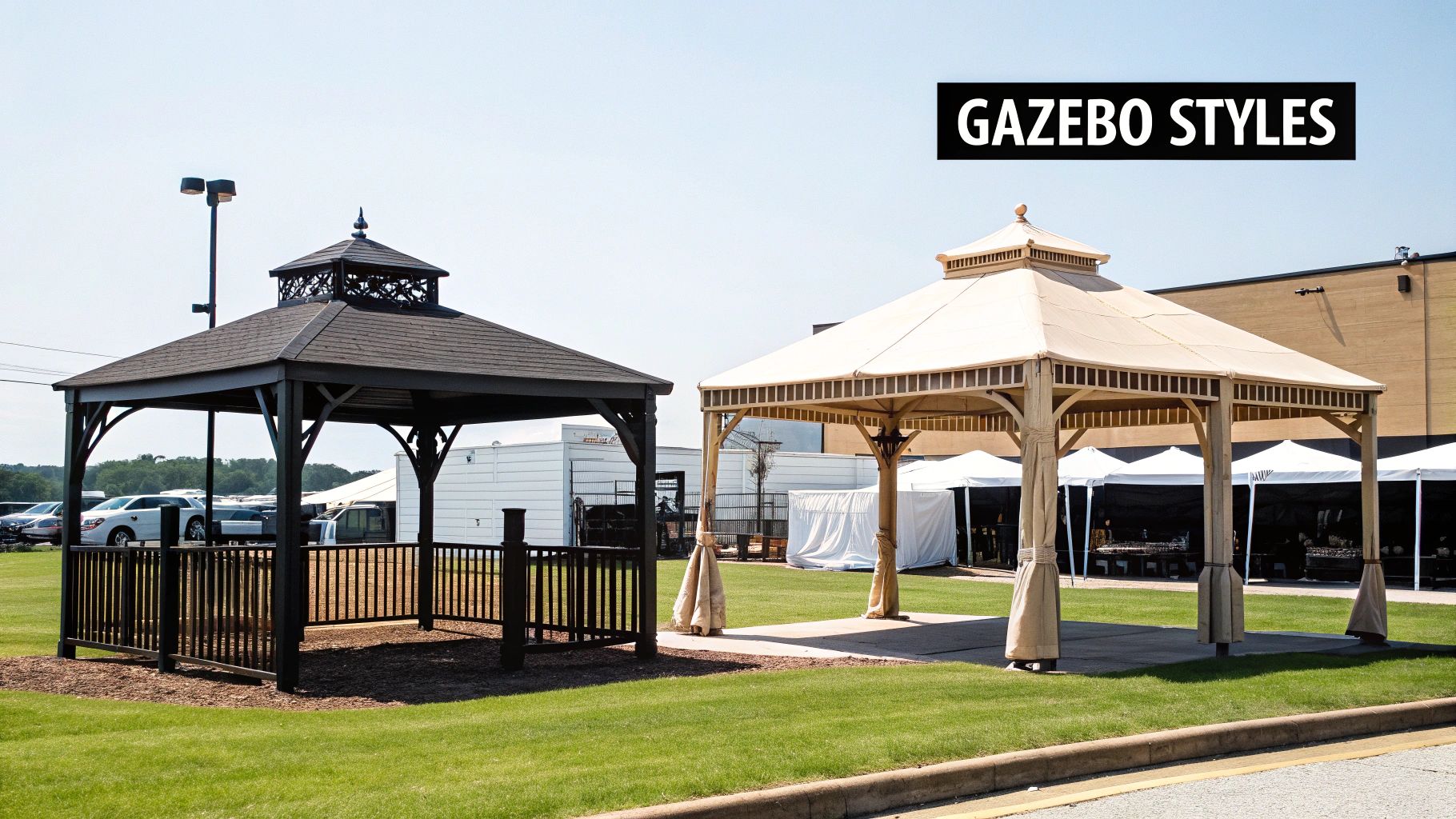
Choosing the right gazebo is about so much more than just putting a roof over your guests’ heads. It’s about creating an atmosphere and making sure everyone is comfortable. Nail the size and material from the get-go, and you’ll avoid those last-minute logistical nightmares that can derail an otherwise perfect event.
One of the most common slip-ups we see is underestimating how much space is actually needed. A gazebo that’s too small feels cramped and unwelcoming. Go too big, and a smaller, intimate event can feel sparse and lost. The real trick is to think about what your guests will be doing in that space. Are they standing around mingling with a drink, or will they be sitting down for a proper meal?
Matching Gazebo Size to Your Event
First things first, get a headcount. But don’t stop there. You need to think about the layout. A cocktail-style event where everyone is standing means you can fit more people in. If you’re planning a seated dinner, you have to account for tables, chairs, and enough room for people to push their chairs back and walk around without bumping into each other.
A standard 3x3m pop-up gazebo is a brilliant, versatile choice for smaller needs. It’s spot-on for a vendor stall at a weekend market, a ticket booth, or even just a dedicated drinks station at a garden party. For anything bigger, you’ll want to look at a more substantial structure or even link multiple gazebos together to create a custom-sized venue.
A great rule of thumb is to allow roughly 1.5 square metres per person for a standing reception. If guests will be seated at tables, you’ll want to bump that up to around 2 square metres per person. This guarantees everyone has a bit of breathing room.
To make things a bit easier, here’s a quick reference table to help you visualise the space you might need.
Gazebo Size And Capacity Guide
This handy guide should give you a solid starting point for figuring out what size gazebo will best suit your guest list and event style.
| Gazebo Size (Metres) | Standing Capacity (Approx.) | Seated At Tables (Approx.) | Common Use Case |
|---|---|---|---|
| 3m x 3m | 10-12 people | 6-8 people | Market stalls, small garden parties, info booths |
| 3m x 6m | 20-25 people | 15-18 people | Medium-sized gatherings, buffet setups, bands |
| 6m x 6m | 40-50 people | 30-35 people | Small weddings, corporate functions, parties |
Using a practical guide like this ensures that when you opt for a gazebo for hire, you’re getting a space that truly works for you. Here in South Africa, the event hire business is huge, and pricing reflects that versatility. You can expect to see daily rates ranging from R350 to R2,200. For that popular 3m x 3m size, you’re often looking at between R450 and R650 per day, excluding VAT. It’s always a good idea to learn more about typical rental rates to find a provider in your area.
Understanding Materials and Frames
The material of your hired gazebo is just as critical as its size, especially with South Africa’s famously unpredictable weather. Your choice here will directly impact how well your event holds up against sun, wind, and the occasional downpour.
Most rental gazebos you’ll find have canopies made from one of two materials: polyester or PVC.
- Polyester: This is a very common, lightweight option that gives you good UV protection and is water-resistant. It’s perfect for a sunny day with a chance of light showers – think casual daytime events where a massive storm isn’t a major worry.
- Heavy-Duty PVC: When you need serious weather protection, PVC (polyvinyl chloride) is the undisputed champion. It’s 100% waterproof and far more durable than polyester. This makes it the go-to for weddings and corporate events where you absolutely cannot afford any weather-related mishaps.
Now, let’s talk about the frame. The frame is what gives the gazebo its stability. Aluminium frames are light and super easy to set up, which is great for the pop-up kind. But if you’re dealing with windy conditions, like a breezy afternoon in Cape Town or a Highveld thunderstorm, a heavier steel frame provides that essential sturdiness and gives you total peace of mind.
Lastly, don’t overlook the option of adding side walls. For many events, they’re a non-negotiable. They offer brilliant protection from wind and driving rain, give your event some privacy, and can help create a cosier, more enclosed atmosphere when you need it. Most hire companies offer them as an optional extra, and they are well worth the small additional cost for the flexibility they bring.
Getting to Grips with Gazebo Hire Costs in South Africa
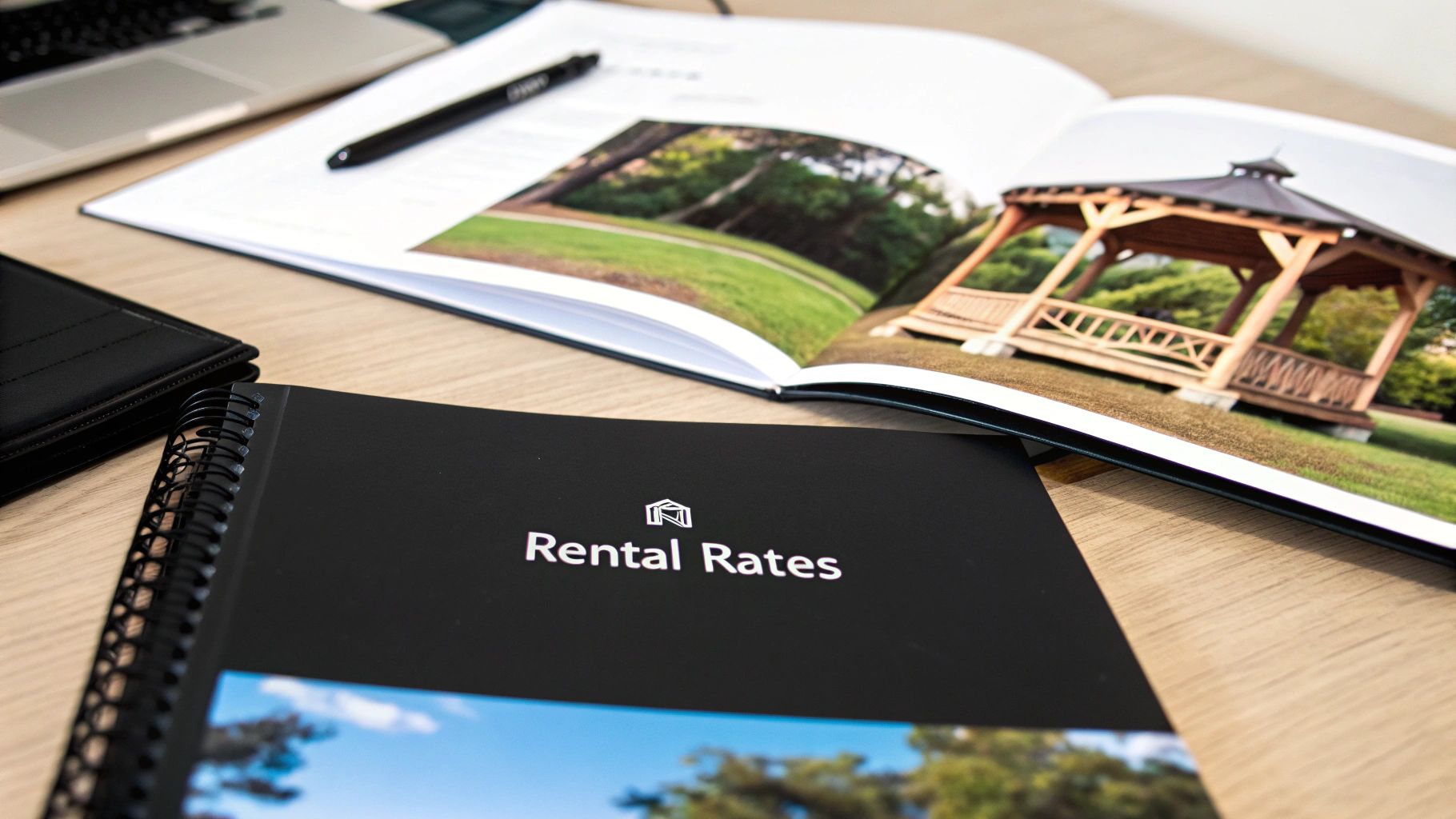
Figuring out the true cost of hiring a gazebo isn’t just about the daily rate you see advertised. While that number is a good starting point, a few other things can pop up and change the final invoice. Nailing down a clear budget is key for any event, so let’s walk through all the potential costs you should expect.
This way, you can confidently compare quotes from different companies, knowing you’re looking at the whole picture. From delivery fees that depend on distance to those optional extras that add a bit of flair, we’ll cover every part of the price.
The Basic Daily Hire Fee
At the heart of any quote is the daily fee for the gazebo itself. This price is mostly decided by the size and quality of the structure you pick. A simple 3x3m pop-up gazebo, for instance, is going to be your most budget-friendly choice, perfect for a market stall or a small get-together in the garden.
As you start looking at larger, tougher structures with heavy-duty PVC tops and solid steel frames, the price naturally goes up. Across South Africa, you’ll find a wide range of pricing that shifts based on your location, the scale of your event, and even the time of year.
Generally, you can expect to hire a smaller gazebo (like a 3m x 3m) for around R450 to R650 per day. For bigger setups, many companies charge per square metre—usually between R30 and R50. The good news is that larger tents often work out cheaper per square metre. You can dig a bit deeper into these costs by checking out typical marquee and tent rental rates in South Africa.
What Else Comes into Play? Added Service Costs
This is where you can get caught out if you’re not careful. Most quotes will list these services separately, so always read the fine print.
- Delivery and Collection Fees: This is a big one. The cost is all about the distance from the company’s warehouse to your event spot. A delivery to Sandton will obviously be cheaper than a trip out to a remote farm in the Karoo. Always give an exact address to get a spot-on quote.
- Setup and Takedown Labour: While you might be able to DIY a smaller gazebo, most professional hires include their team for setup and takedown. This fee covers the crew’s time to safely put up the structure and dismantle it afterwards. Honestly, it’s money well spent for the peace of mind.
- Side Walls and Extras: Need side walls to block the wind or for a bit of privacy? They’re almost always an optional extra. The same goes for things like flooring, lighting, or weights to hold the gazebo down on hard surfaces like paving.
Don’t just glance at the main price on a quote. A daily rate that looks cheap at first might be hiding higher delivery or labour charges. Always compare the total, all-in cost before you make a decision.
How Timing and Duration Can Change the Price
When your event is happening can also make a real difference to the cost. Just like booking a venue, demand for gazebos goes up and down throughout the year.
Hiring a gazebo for a Saturday in December, right in the middle of wedding and year-end party season, is likely going to cost more than for a Wednesday in May. If you have some flexibility with your date, think about an off-peak or mid-week booking to possibly get a better deal.
Also, hiring for several days usually comes with a nice discount. The daily rate for a three-day festival will be much lower than paying the single-day rate three times over. Companies love longer bookings, so make sure you tell them your full required dates upfront to get the most accurate and budget-friendly price.
Navigating the Booking and Delivery Process
So you’ve picked out the perfect gazebo. Fantastic! Now comes the part that a lot of people find daunting: the logistics. But honestly, securing your gazebo hire should be the easy part. A smooth process from your first call right through to the final collection is what really sets a great hire company apart from a merely good one.
To get the ball rolling quickly and get an accurate quote, it’s a smart move to have a few key details handy before you even pick up the phone. A little bit of prep saves a ton of back-and-forth and makes sure the price you’re quoted is the price you’ll pay.
Securing Your Booking
When you first make contact, you can speed things up significantly by providing a few key pieces of information. Here’s what any good hire company will need to give you a solid quote:
- Your Event Date and Times: Be precise. Knowing the exact day and the hours you need the gazebo lets the company check their inventory straight away.
- The Full Venue Address: This is a big one. Delivery fees are almost always calculated based on travel distance from their warehouse, so an exact location is crucial.
- Surface Type: Let them know if the team will be setting up on grass, paving, sand, or something else. This tells them exactly what anchoring equipment they need to bring to keep the structure safe and secure.
- Your Specific Needs: Don’t forget to mention any extras. Do you need side walls for weather protection? What about flooring or lighting to complete the look?
With these details, any professional outfit can give you a comprehensive quote that covers everything. To lock in your booking, you’ll usually be asked for a deposit, which is often around 50% of the total cost. The remaining balance is typically due a few days before your event, or sometimes on the day of delivery.
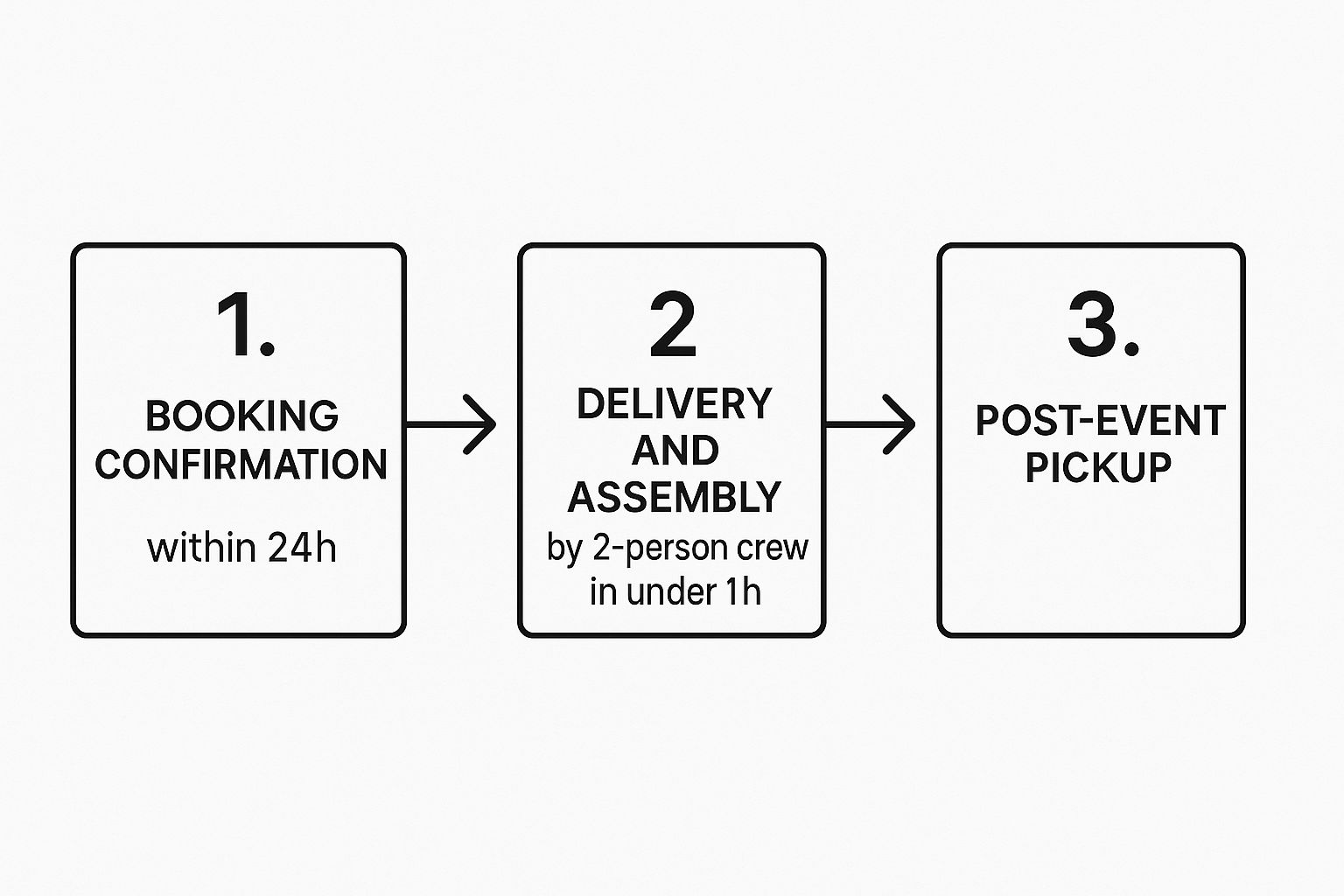
Preparing for Delivery and Setup
On the big day, good communication with the delivery crew is everything. Before they even set off, have a think about site access. Is it easy for their delivery vehicle to get close to the setup spot, or will they have a long trek carrying heavy equipment?
Do a quick sweep of the area and clear any potential obstacles out of the path. This might mean shifting some pot plants, moving garden furniture, or having a word with the venue manager to make sure a loading bay is free. The less time the team spends navigating a maze, the faster your gazebo goes up.
Here’s a pro tip: When the team arrives, take five minutes to do a quick inspection of the equipment with them. Check the canopy for any marks or tears and make sure the frame looks solid. This simple check protects both you and the hire company and prevents any awkward conversations about pre-existing damage later on.
Confirm the final placement with the crew before they start assembling. This is your last chance to make those small but important tweaks, like angling the entrance away from a breeze or making sure it lines up perfectly with a walkway. Once they start building, moving a whole gazebo becomes a much bigger job.
By being there and being proactive, you make sure your hired gazebo is set up exactly where and how you pictured it, ready for a brilliant event.
Gazebo Setup, Styling, and Safety Essentials
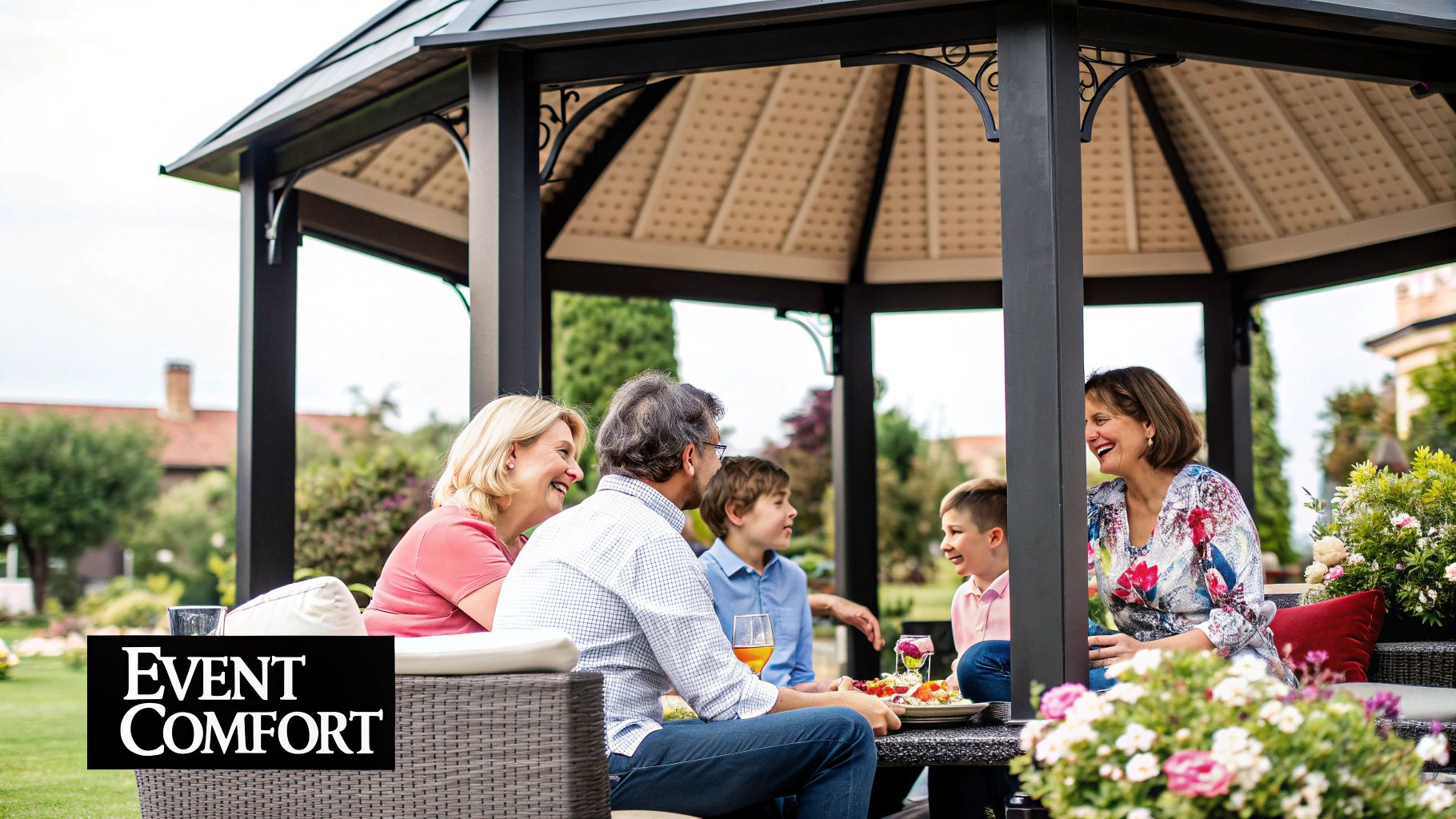
Your hired gazebo is so much more than just a roof over your head; it’s the heart of your event’s atmosphere. Get the setup, styling, and safety right, and you can transform this simple structure into a show-stopping centrepiece. This is your chance to set the perfect mood while making sure your guests are comfortable and safe from the moment they arrive.
Whether you’re doing a DIY setup or just keeping an eye on the professional crew, knowing the basics is key. From anchoring the gazebo properly to adding those final magical touches, every little detail plays a part in making your day a huge success.
Mastering the Setup and Anchoring
Before you even think about fairy lights and drapes, you have to be absolutely sure the gazebo is secure. A sudden Highveld storm or one of Cape Town’s famous “South Easters” can turn an unsecured gazebo into a real danger. The right way to anchor it all comes down to the surface you’re working with.
For a classic garden party on a lawn, heavy-duty pegs or stakes hammered deep into the ground at an angle are your best bet. They offer fantastic resistance against the wind. Most professional gazebo for hire companies will provide these, but it never hurts to double-check.
Working with hard surfaces like paving, concrete, or a deck? That’s a different story. You can’t use stakes, so heavy weights are absolutely essential.
- Sandbags are a popular choice, usually weighing 20kg or more for each leg.
- Concrete blocks or custom-made weight plates give you even more stability.
- Water-filled weights are another great option, as you can fill them up right there at the venue.
A common mistake is to only weigh down two legs—always secure a weight to each leg. This stops the structure from twisting in strong winds. A securely anchored gazebo is the first step to a safe event.
And if you’re planning a beach event, you’ll need special sand pegs. They’re much longer and wider than standard grass stakes, designed to get a solid grip in shifting sand.
Bringing Your Gazebo to Life with Style
Once your gazebo is standing strong, the fun can begin. Styling is all about injecting your personality and event theme into the space. Even a few simple, budget-friendly additions can make a huge difference to the overall vibe.
Lighting is probably the single most powerful tool for creating atmosphere, especially as day turns to night.
- Fairy lights or string lights woven through the frame or draped along the edges cast a warm, inviting glow.
- Uplighters tucked into the corners can wash the space with colour to match your theme.
- Festoon lights strung across the ceiling give off a vintage, festive feel that’s perfect for weddings and parties.
Draping soft fabrics like tulle or organza can instantly soften the look of the metal frame and add a real touch of elegance. Try wrapping the legs or creating a beautiful swagged ceiling. Pair this with comfy seating, a few well-placed pot plants, and maybe a small pop-up bar, and you’ve created a complete, welcoming space. For a bit of extra fun, you could even look into a cotton candy machine hire to treat guests of all ages.
Your Final Pre-Event Safety Checklist
Safety doesn’t stop once the structure is up. Before your guests start arriving, do one last quick but crucial check to make sure everything is perfect. It only takes a few minutes and gives you total peace of mind.
- Check All Connections: Give the frame a gentle shake. Are all the poles locked in properly? Is the canopy pulled tight and fastened securely?
- Verify Anchoring: Go around and double-check that every single leg is properly staked or weighted down. Give the weights a nudge to make sure they’re heavy enough and won’t slip.
- Inspect the Area: Do a quick walk-through inside and around the gazebo. Keep an eye out for any tripping hazards, like loose lighting cables or exposed pegs.
- Monitor the Weather: Keep the weather forecast handy. If strong winds or heavy rain are on the way, you might need to add extra weights or attach side walls for more protection.
Common Questions About Gazebo Hire
Even when you think you’ve got all the big details sorted, a few last-minute questions always seem to surface right before you book. Getting these sorted is the final step to feeling completely confident in your choice.
Here, we’ll walk through the most common queries we get about hiring a gazebo, giving you practical answers to make sure you’re fully prepared.
What Happens if the Hired Gazebo Gets Damaged?
Accidents happen, we get it. But it’s always best to know what the process is just in case. Any good hire company will have a clear damage policy in their agreement. Typically, you’ll be responsible for damage that’s more than just standard wear and tear – think a nasty rip in the canvas or a bent frame.
Most companies take a refundable security deposit to cover these kinds of things. This is exactly why it’s so important to give the gazebo a quick once-over with the delivery team when it arrives.
Here’s a pro tip: snap a few quick photos of the gazebo right after it’s set up, especially if you spot any little scuffs or marks already there. It gives you a clear record and helps avoid any mix-ups about damages when the team comes to collect it.
Always take a moment to read the terms and conditions about liability in your hire contract. Some companies might even offer a damage waiver for a small extra fee, which can be great for peace of mind.
Do I Need a Permit to Set Up a Gazebo?
This is a big one, and the answer really comes down to your venue. If you’re hosting an event in your own garden or on private property, you almost certainly won’t need a permit. You’re free to set up as you wish.
However, things change completely if you’re using a public space.
- Public Parks: Setting up in a municipal park in places like Johannesburg or Durban will definitely require getting permission from the local council.
- Beaches: Events on the coast, especially popular beaches in Cape Town or along the Garden Route, have very strict rules.
- Community Fields: Even open community spaces usually need to be booked, with formal approval needed for any structures.
It is always your responsibility to check with the local authority and get any permits you need well ahead of time. Don’t leave it to the last minute, because the application process can sometimes take a few weeks. Your best bet is to start with a quick call to your local municipality office.
Can I Hire a Gazebo for Multiple Days?
Yes, absolutely! This is something we handle all the time. Whether you’re putting together a weekend festival, a multi-day market, or a corporate event, longer hire periods are standard.
In fact, you’ll often find that hiring for a few days gives you better value. Most companies will offer a pretty good discount on the daily rate after the first day. The first day’s cost covers the heavy lifting of transport and labour, making each extra day much more affordable.
When you ask for a quote for your gazebo for hire, just be sure to give the full start and end dates. That way, the price you get is spot-on and includes any long-term hire discounts.
Are Rental Gazebos Fully Waterproof?
How much protection you get from the weather really depends on the quality of the gazebo. The commercial-grade gazebos you’ll find for hire are highly water-resistant and built to handle light to moderate rain just fine.
The real difference is in the material:
- Polyester Canopies: These are fantastic for shade and will keep you dry during a short, light drizzle.
- PVC Canopies: For proper rain protection, a heavy-duty PVC (polyvinyl chloride) canopy is the way to go. It’s 100% waterproof and the top choice for weddings and other important events where keeping everyone dry is a must.
If you want the best possible protection against a real downpour, we highly recommend hiring side walls. They stop rain from blowing in from the sides, keeping the inside space completely dry and comfortable. Always double-check the gazebo’s weather rating with the hire company, especially if your event is during a rainy season.
Planning an unforgettable event in Cape Town or the Winelands? Let ABC Hire provide the perfect shelter and furnishings to bring your vision to life. From stylish gazebos to elegant seating and unique LED furniture, we have everything you need.
Explore our full range of event solutions and get a quote today at https://abchire.co.za.

